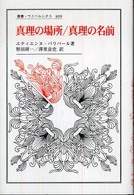- ホーム
- > 洋書
- > 英文書
- > Psychology
Full Description
ALERTcourse syllabus to ensure that you select the correct ISBN. Several versions of Pearson's MyLab & Mastering products exist for each title, including customized versions for individual schools, and registrations are not transferable. In addition, you may need a CourseID, provided by your instructor, to register for and use Pearson's MyLab & Mastering products.NOTE: Make sure to use the dashes shown on the Access Card Code when entering the code.Student can use the URL and phone number below to help answer their questions: http://247pearsoned.custhelp.com/app/home800-677-6337PackagesAccess codes for Pearson's MyLab & Mastering products may not be included when purchasing or renting from companies other than Pearson; check with the seller before completing your purchase.Used or rental booksIf you rent or purchase a used book with an access code, the access code may have been redeemed previously and you may have to purchase a new access code.Access codesAccess codes that are purchased from sellers other than Pearson carry a higher risk of being either the wrong ISBN or a previously redeemed code. Check with the seller prior to purchase.Helping students make connections between science and practice The World of Children helps students connect the science and the practice of child development in a way that can positively change lives. The third edition features an active learning system that exposes students to real people facing real world child development challenges. It encourages readers to think critically about issues from multiple perspectives. The World of Children is a chronological child development text.MyPsychLab is available with World of Children, 3e. Through MyPsychLab, students have access to MyVirtualChild, an interactive web-based simulation that allows students to raise a child from birth to age 18 and monitor the effects of their parenting decisions over time. A better teaching and learning experienceThe teaching and learning experience with this program helps to:Personalize Learning- The new MyPsychLab delivers proven results in helping students succeed, provides engaging experiences that personalize learning, and comes from a trusted partner with educational expertise and a deep commitment to helping students and instructions achieve their goals. Improve Critical Thinking-Prompts throughout each chapter jumpstart readers' critical thinking process. Engage Students- Real-life cases encourage students apply what they are learning. Also, students can raise a child through MyVirtualChild. Explore Research- With over 600 new research citations, this new edition reflects the latest research in the field of child psychology. Understand Different Perspectives- Several perspectives are included in the reading to help students think about the content from different points of view. Support Instructors- New MyPsychLab Video Series. These cross-cultural videos feature original footage filmed in the United States, Mexico, and Botswana. Guided by series editor Ashley Maynard (University of Hawaii, Manoa), they show how culture impacts child development. Videos are available in multiple formats: on an instructor's DVD, tied to quizzes in MyPsychLab, and called out in the chapter with "Watch" icons.
Contents
In this Section1. Brief Table of Contents2. Full Table of ContentsPart One: BeginningsChapter 1: Exploring Child DevelopmentChapter 2: Heredity and the EnvironmentChapter 3: Prenatal Development and BirthPart Two: Infants and Toddlers: The First Years (Birth through 2 years)Chapter 4: Physical Development in Infants and ToddlersChapter 5: Cognitive Development in Infants and ToddlersChapter 6: Socioemotional Development in Infants and ToddlersPart Three: Early Childhood: The Playful Years (3 through 6 Years)Chapter 7: Physical Development in Early ChildhoodChapter 8: Cognitive Development in Early ChildhoodChapter 9: Socioemotional Development in Early ChildhoodPart Four: Middle Childhood: The School Years (7 through 11 Years)Chapter 10: Physical Development in Middle ChildhoodChapter 11: Cognitive Development in Middle ChildhoodChapter 12: Socioemotional Development in Middle ChildhoodPart Five: Adolescence: The Transition toward Adulthood (12 Years and beyond)Chapter 13: Physical Development in AdolescenceChapter 14: Cognitive Development in AdolescenceChapter 15: Socioemotional Development in AdolescencePart One: BeginningsChapter 1: Exploring Child DevelopmentDefining the FieldTheories of Child DevelopmentUsing the Scientific Method: Research in Child DevelopmentApplications of Child Development Research and Careers Related to ChildrenChapter 2: Heredity and the EnvironmentGenes and Human ReproductionHow Traits and Genetic Abnormalities Are InheritedHow Genes and Environments InteractBehavior Genetics: Measuring the Heritability of TraitsChapter 3: Prenatal Development and BirthPrenatal DevelopmentTeratogens: Health Risks for the BabyThe Process of BirthBecoming a Family: Psychological Adjustments to Having a NewbornPart Two: Infants and Toddlers: The First Years (Birth through 2 years)Chapter 4: Physical Development in Infants and ToddlersInfants at Risk: Prematurity and Infant MortalityGrowth of the Body and BrainSensory CapabilitiesMotor DevelopmentChapter 5: Cognitive Development in Infants and ToddlersPerceptual DevelopmentExplaining Cognitive Development: Piaget's Constructivist ViewLearning to CommunicateChapter 6: Socioemotional Development in Infants and ToddlersAttachmentTemperament and EmotionSocial Relations and PlayPart Three: Early Childhood: The Playful Years (3 through 6 years )Chapter 7: Physical Development in Early ChildhoodGrowth of the Body and BrainMotor Development and Physical ActivityHealth and Safety IssuesChapter 8: Cognitive Development in Early ChildhoodPiaget's Stage 2: Preoperational ThoughtVygotsky's Sociocultural View of Cognitive DevelopmentInformation ProcessingLanguage DevelopmentEarly Childhood Education and Kindergarten ReadinessChapter 9: Socioemotional Development in Early ChildhoodThe Social and Emotional SelfParentingFriends and PlayPart Four: Middle Childhood: The School Years (7 through 11 Years)Chapter 10: Physical Development in Middle ChildhoodGrowth of the Body and BrainMotor Development and Physical ActivityHealth and Safety IssuesChildren with Exceptional NeedsChapter 11: Cognitive Development in Middle ChildhoodPiaget's Stage 3: Concrete Operational Thought (Ages 7 through 11)Information Processing: Memory DevelopmentInformation Processing: Knowledge, Strategies, and New ApproachesLearning to Communicate: Language in Middle ChildhoodCognition in ContextChapter 12: Socioemotional Development in Middle ChildhoodThe Social and Emotional SelfFamiliesPlay, Friends, and Peer PopularitySchools and the MediaPart Five: Adolescence: The Transition toward Adulthood (12 Years and beyond)Chapter 13: Physical Development in AdolescenceGrowth of the Body and Brain during AdolescenceSexual Activity during AdolescenceSpecial Concerns about Teenage Sexual ActivityAdolescent Health IssuesChapter 14: Cognitive Development in AdolescencePiaget's Stage 4: Formal Operational Thought (12 Years and Above)Recent Sociocultural Views of Cognitive DevelopmentIntelligenceLearning to Communicate: Language in AdolescenceCognition in Context: Adolescents Making DecisionsChapter 15: Socioemotional Development in AdolescenceWho Am I? Adolescents' Understanding of ThemselvesSocial Relationships: FamilySocial Relationships: Peers Contexts of Development








